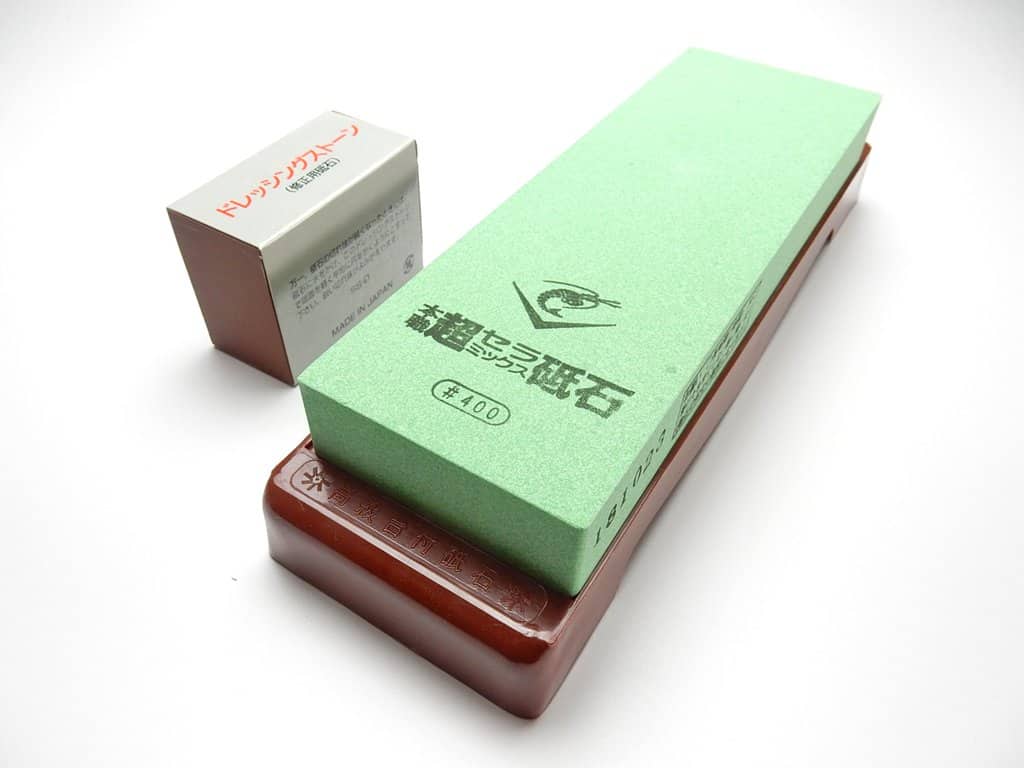Part 1 of Neil Miller’s series on Hones.
Call them what you will: whetstones, sharpening stones, water stones or whatever – sooner or later your razor will have to come into contact with one or more of these. For our purposes we are only concerned with stones that use water as a lubricant, so oil-stones do not apply. They come in a large assortment of grades (aka grit sizes) from very coarse to ultra-fine. The very coarse grades (eg 325 grit) are for taking off a lot of metal at a very rapid rate. A typical use would be to remove a chip or nick from the razors edge and set a new bevel (the bevel is kind of “v” shaped in cross-section – the bevel planes on each side of the “v” must meet exactly, or no further amount of polishing/honing on successive hones will sharpen the blade).
Once the bevel is set, all we are doing is refining it. A rough rule of thumb is for the next hone to be approximately twice the grit rating of the last stone – the higher the grit size, the finer the hone. The series of stones used from setting the bevel to the final polishing of the blade is known as the “honing progression” – mine, for example, is 325, 600, 1000, 2000, 5000, 10,000 and 16,000. Once we have used a 4000, 5000 or 6000 gritstone, very little metal is removed from the bevels on advancing up the honing progression. If the bevel is not properly set by now, it is time to go back to a coarser stone. Imagine the “v” not coming to a point, but having a small flat area at its peak before the next bevel coincides with it – all the finer stones will do is polish the steep face of each bevel, not remove the flat area at the top of the “v” so the blade will never be truly sharp and be unfit to shave with.
When to stop refining (or polishing) the bevel is a matter for personal choice. 8000 grit seems to be about the practical limit, while 10,000 will often give a superior shave. I stop on a 16,000, sometimes a 20,000 grit hone but many people go higher. The process of refinement need not stop with the honing stones – many people go from the final hone to a pasted paddle or strop and further refine the edge with compounds, powders, and pastes.
You can over-refine the edge though. Excessive laps (on any hone, not just the finisher) will do this, leaving a weak and attenuated cutting edge. The remedy is to de-burr the edge if necessary (ie remove the fin or burr, drawing the edge over a bit of horn will do this) and dropping down to the previous hone.
USES
Damage Removal
To remove larger nicks, dings, fleabites – call them what you will, coarse hones must be used, for example between 325 grit and 1000 grit rating. For tiny areas of damage hones in the region of 1000 – 4000 grit will suffice. The coarser hones are also excellent at removing blade honing defects, like frowns (a narrower width in the middle of the blade) and smiles (a wider width in the middle of the blade). This is done by sawing the blade back-and-forth (called “breadknifing” because the action is like cutting a slice of bread) until the profile is straight. Note that some smiles were intentional, particularly among older open razors. Such razors are often said to be more comfortable and forgiving to shave with, and some old barber manuals go into detail about setting a smile on a straight blade.
Essential Maintenance
Otherwise known as “touching up” – this is required whenever the blade feels a little dull after stropping or as a regular routine for keeping the edge in tip-top condition. All you need is a finishing hone, somewhere in the region of 10,000 grit or higher. Not may strokes are necessary – or desirable – about 5 laps should do it on a small barber-type hone (a lap is counted as a stroke one way plus a stroke the other way). On larger hones perhaps 2 or 3 laps is all that is required.
PRELIMINARIES
Using a Slurry
Some – though by no means all hones – can be made more versatile by the use of a slurry. Such hones are wetted and rubbed with a small piece of stone (it may be the same type of stone as the hone or a softer stone such as a nagura or artificial nagura) until a thin, milky slurry builds up. When used like this, the slurry constantly micro-abrades the surface of the hone so that fresh particles are exposed, making the honing go much faster. The downside is that it also makes the blade edge a little less refined. To get around this, towards the end of honing the slurry is constantly thinned with water until only water remains. This will make the edge more finely polished and more refined. Some hones can even be used dry to get a bit more refinement from them. Don’t expect to jump from say 4000 to 8000 grit on the same stone, though!
Lapping a Hone
Apart from diamond plates, all hones should be “lapped” (flattened) before use. Even those that are said to be ready to use straight from the vendor should be regarded with some suspicion and lapped as a matter of course. A diamond plate (see caveats under the relevant section) is quite handy to use, but not essential. All you need is a flat surface such as a thick sheet of plate glass, granite or marble and a number of grades of wet’n’dry paper and plenty of water. Don’t use normal sandpaper. Pour a small puddle of water onto the glass and lay the wet’n’dry on it, face up – the water will set up a suction and hold the paper in place. Soak the hone (if it is capable of being soaked) and draw a grid of lines with a pencil all over the surface to be lapped. Pour a puddle of water on the paper and lay the gridded face of the hone on it, then move it backward and forwards as if sanding the surface. Every now and then remove the stone and look at the gridlines – areas, where they have vanished, indicate high areas on the hone, where the lines remain represent low areas on the hone. Keep flushing the paper with water and moving the hone over it until all the gridlines have vanished. To make doubly sure the hone is flat, draw another grid on it and repeat. This routine is repeated on each ascending grit of wet’n’dry – you might want to start with a P100 grit and work up to P600 by way of P240 and P400, for example.
TYPES OF HONE
There a number of different types of hone, man-made, ceramic, diamond plate and natural stone are, broadly speaking, the main types – although of course there are others. What to buy depends on personal choice, price, speed of operation and how much use you intend to give the hone, eg whether you hone for other people or just for yourself. Any recommendations I give are, of course, restricted to the hones I have used, are only my own personal opinions and other people may have conflicting views.
Man-Made/Synthetic/Artificial Hones
These can be had in all grit ratings, generally need soaking in water before use and are quite fast to very fast in operation. They can be one grit all the way though, or “combination” hones – two grits, one on either side. Makers include King, Ice Bear, Norton, Naniwa, etc. In my opinion, the very coarse hones are not worth the bother – they need “lapping” or flattening (see later) very frequently – too frequently for my liking. The ones I have used for chip removal have required lapping during honing, otherwise, the surface rapidly becoming concave had a deleterious effect on blade profile. They also drink water like it is going out of fashion – a 220 grit stone I used (Sun Tiger) was dry after 5 laps of the razor, even after having been soaked for 30 minutes. A bit much when a 100 laps or so are necessary to remove a small chip.
King
In this series (in my opinion), anything over 1000 is fine – they don’t require lapping too often and they don’t require as much water – an initial soak followed by spraying at intervals suffices. I have used a number of 1000 grit king stones and found them to be fast, relatively cheap and easy to obtain. They are a bit ‘soft’ in composition though and need lapping more than most other 1k hones I have come across. It is also available as a combination 1000/6000 stone which is very useful. The 6000 side is also a great performer. I personally rate these stones as better than the Norton 4000/8000 combination stones which are hard to come by at reasonable prices in the UK. These are used with a slurry, produced by rubbing a small slurry stone over the wet surface of the hone. If anything, they are faster than the quoted grit value, for instance, the 6k side is more like 5k.
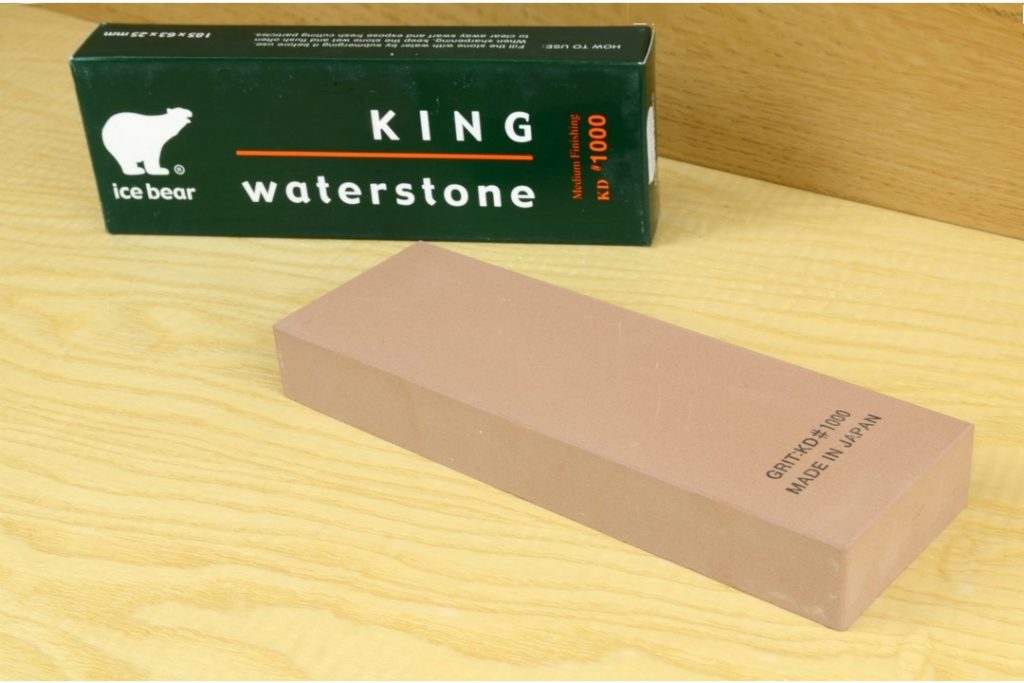
Naniwa Chosera
At the time of writing, these are among my favourite hones. The 1k hone is outstanding – a perfect bevel setter. This is followed by a 3k, 5k, and 10k hone. The 10k although high grit rating is not what I would call a finishing hone – rather it is a pre-finisher. There are also problems with the 10k – I have had two now, the first being sent back after six months because the surface became finely crazed. The replacement lasted over a year before this crazing appeared again and on inspection, the 5k showed some small signs of beginning to show hair-line crazing. It lapped out of the 5k but seems pretty deep in the 10k. Lapping it before use ensures that there is no problem, but I would prefer it if it was not displaying this tendency. Like other man-made hones of this type, there is a little differential movement in the hone, most noted at the fine grit end of the range. They come with a huge ‘rubbing’ or cleaning stone and are available with or without a plastic base.
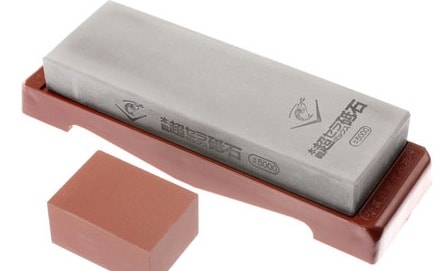
Naniwa Super Hone
The Naniwa Super Hone series has very good feedback and is cheaper than the Nainwa Chosera series. I have used the whole range, from 1000 to 12,000 grit. All are very good – the 1000 is very fast (they are all quite fast in use) and both the 10,000 and 12,000 are ideal for final finishing hones. Each hone hardly needs more than a small spray of water and although soft they do not require lapping that often. They are very easy to lap, too, being soft – the only problem is “stiction” – a diamond plate is apt to stick quite doggedly to the hone unless the operation is carried out underwater, under running water or a special perforated or grid-marked lapping plate is used. This holds true for a lot of other stones, too. The range is prone to dimensional changes, however, and should not be left in direct sunlight or next to open fires or radiators. No slurry or rubbing stone is required. They come with or without a plastic base and some combos are to be had.
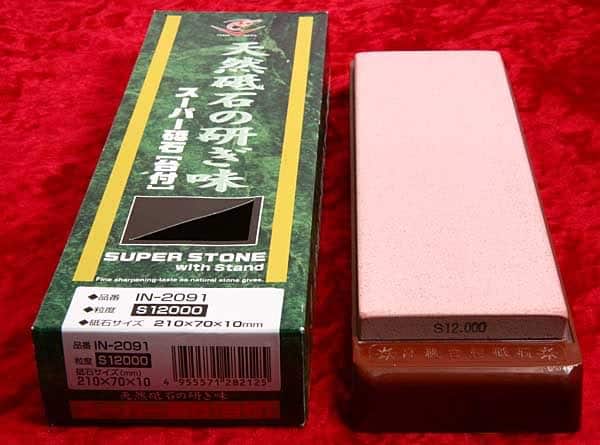
Ceramic Hones
Examples of these would be the small, old-style “barber” or razor hone, Spyderco and Shapton hones and some ranges of modern hones. The barber-style hones are great for travelling with as they are so small – most aren’t more than six inches long – but this makes them a bit restrictive (at least for me) to use all the time. They are generally of a high-grit rating – say about 10,000 and above, unless you manage to find one of the rarer combination types with a coarse and a fine side. The vintage Swaty hones usually receive good reviews, particularly the type called “three-line” (so known because it has three lines of writing on them). They are old now, and every one I have had has needed lapping. They are very hard usually, making lapping a bit of a chore, but not only does it level the surface it also helps to refine the grit to some extent, making some of them finer in operation.
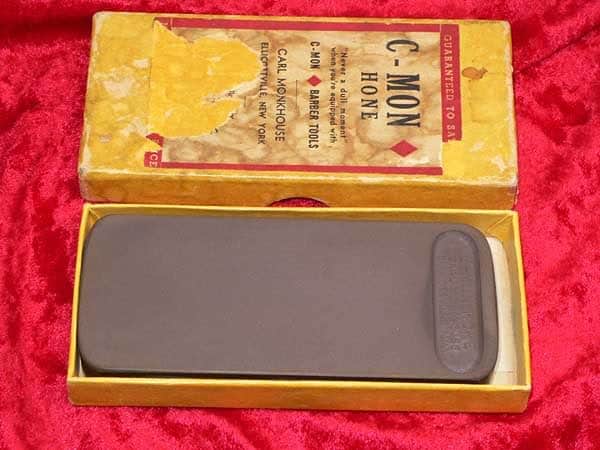

Suehiro Gokumyo Ceramic Whetstone
I have the 20k version of this hone and can say it is an excellent hone, on a par with the Shapton 30k Glass Hone. It is fairly hard for the type but gives a truly keen yet smooth edge. It is also quite thick compared to Shapton Glass Stones for example, but even costlier and harder to obtain in the UK. It is one of my favourite finishing hones.
Sigma Power Ceramic Stone
These come in a range but I have only used the 13k one. It is a nice stone, with a ‘soft’ feel although ceramic, and a very good finisher. However, it is often hard to get and sometimes hard to fit into an existing honing progression, depending on the types of hone you already have.
Spyderco
These are very hard and unforgiving, and they come in medium, fine and extra-fine grades and tend to be on the small side compared to other hones, but they are longer than old-style barber hones. The one of choice is the ultra-fine variety, indeed it was originally formulated as a modern barbers hone! I have used them more as bases to hold various fine compounds, and they excel at this.
Shapton Glass Stone
I have used four Shapton Glass Stones (so-called because the backing is a flat plate of glass) – 2000, 8000, 16,000 and a 30,000 grit. All are soft compared to most natural hone stones but do not require over-frequent lapping and they are very fast in use. However, “soft” needs some qualification: by soft I mean they do not feel like a glassy, hard stone in use, although in actuality they are quite hard – especially the 16,000 and 30,000 glass hones. This does not mean that they are a chore to lap – the hardness is nothing like that of a natural stone! The lower grits in this range are quite affordable, but the price rises quite steadily and by the time you get to the 30,000 hone you really have to justify the price. The 30,000 is about the same grit rating as chrome oxide powder, but to my mind better in use. However, I find that not all steels take to it – it over-refines some steels (particularly older Sheffield steels) and is detrimental to the edge. On modern hard steels, it is fine. Some people recommend sticking with an all-Shapton line-up, saying that Shaptons don’t get on with other hones. Mine has never expressed an opinion, though! No slurry or rubbing stone required.
Shapton Pro series.
Shapton has another series of razor hones – Shapton Pro, much thicker and with no glass backing. They are considerably more expensive, though. I have the 15k hone. It is a very capable finisher, leaving a smoother edge than the 16k glass hone. Compared to other hones of the type, it is relatively soft and leaves a good edge on older steels like you find in early Sheffield steel razors.
Diamond Plate Hones
These are available in a number of grit sizes and from a number of manufacturers. I only have experience with the DMT, Atoma, and Shapton range, so that’s what will be discussed.
DMT
These hones are basically a well-graded diamond dust bonded onto a solid steel plate. Obviously, they need no lapping. Ever. Some types are coated all-over with diamond dust, others have little dots of diamond dust on them. Use the former for straight razors (they are also known as “continuous surface” hones). They need to be “seasoned” a bit before use on a razor – usually by drawing scrap steel (eg a screwdriver shaft) over the surface for some time. This clears the surface of any irregularities and build-ups. The range goes from Extra Coarse (325 grit) through Coarse, Fine, Extra Fine and Extra-Extra Fine. The latter is a particularly useful hone, designated DMT D8EE and being about 8000 grit. I use the extra-coarse and coarse for breadknifing, profiling and chip removal. They handle most materials with ease, though some materials are so hard (eg novaculite stones such as Arkansas) they actually reduce the efficiency of the diamond plate (and strip the surface of the finer diamond plates). A lot of people use diamond plates for lapping waterstones and the like, but care should be taken here – it is better to use the coarser plates and keep them liberally doused with water – or even use them underwater, or the fine paste that builds up can spoil the surface – with the D8EE for example, people have reported areas of the plate losing patches of its diamond covering.
Atoma
In some ways, these are preferable to DMT continuous plates, mainly because the diamond particles are more randomly spread, and ‘stiction’ (sticking of the plate to the hone) is not such a problem. They are very fast in use and highly recommended, although only a limited number of suppliers hold them. I have the 140 grit and the 400 grit and use them exclusively for lapping. For what they are, the price is quite reasonable. Although I do hone defects out with the DMT plates I do not use Atomas for this, as they appear to be even more aggressive than DMTs.
Shapton
This plate is a bit of a beast – it has a rubber surround enclosing a die-cast plate with deep channels, the upper surface of which is covered with diamond dust in the region of 325 grit. It is longer than usual, wide, and the channels prevent it from sticking to the plate. Obviously, they are only for lapping hones on. They work well – for a limited period in my experience. After many cycles of hard use, they lose a lot of ‘bite’ (as do all diamond plates), but considering the outrageously hard cost, this is even more painful to bear. Because of the price I can not recommend them.
